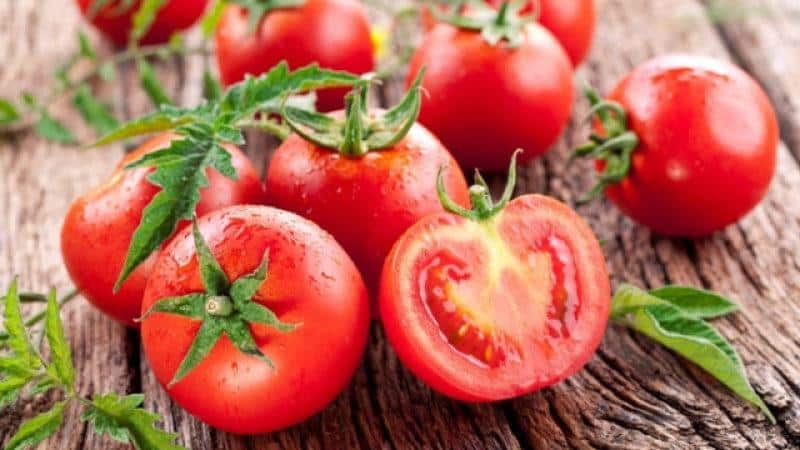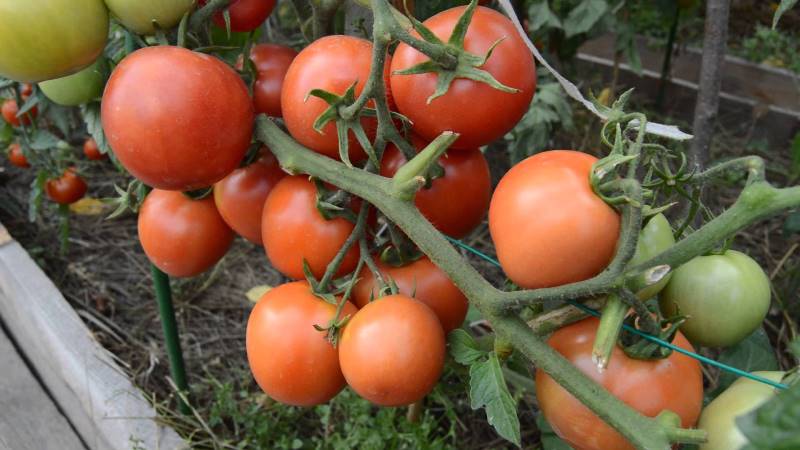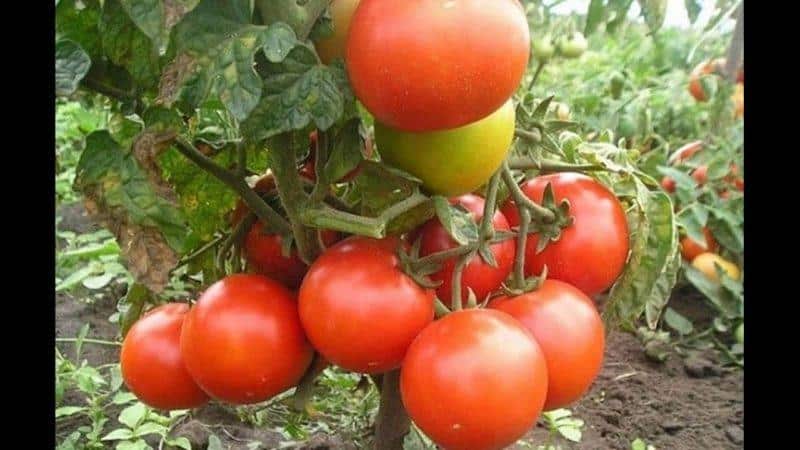Disease-resistant and easy-to-care tomato "Gina" - a practical guide to growing
Many breeders are trying to develop tomato varieties that are easy to care for and resistant to pests, but at the same time produce a rich and tasty harvest. Such varieties already exist, and one of them is variety Gina.
The variety was developed by Dutch breeders, but it has gained popularity all over the world. We will look at the description of the Gina tomato variety, photos and reviews below.
Features of the variety
Gina is relatively young variety in the agricultural industry, but has already gained popularity. Refers to low-growing (determinant) tomatoes. The bushes form three stems growing from the roots and reach a height of 50-60 cm.
The plants are easy to care for and do not require standard procedures for tomatoes such as gartering, shaping, and pinching.
The Gina tomato variety is large-fruited, mid-ripening - 110-120 days pass from the appearance of the first shoots to the full ripening of the fruit. The first brush begins to be laid above the 8th sheet, the rest - after 1-2 sheets.
Suitable for growing both in greenhouses and in open ground. It does not tolerate temperature changes well, so when planting in open ground, additional temporary shelter may be required, for example, a temporary greenhouse.
The variety is resistant to late blight, verticillium, fusarium, and root rot.
The fruits are round in shape, bright red in color, the surface is smooth, not ribbed. The weight of one fruit is about 200-300 g. One tomato has 6-8 chambers with seeds.One cluster produces 3-5 fruits, which do not ripen all at once, but in stages.
The skin of the fruit is thick and dense. The pulp is fleshy, soft, aromatic and juicy. The taste of the pulp is sweetish, pleasant, with a slight sourness.
Thanks to their thick, dense peel, tomatoes tolerate transportation well and are stored for a long time. When properly stored, they do not lose their commercial qualities and excellent taste for a very long time.
Note. If the ripe fruit is placed in a sterile glass jar and placed in a cool place, the tomato will stay fresh for three months.
The photo shows the Gina variety

The Gina variety has a hybrid called Gina TS. A hybrid is an organism or cell that has been created by crossing genetically different forms to produce specific properties. Hybrid seeds cannot be used for planting.
Gina TS is a variety of variety that is characterized by high yield and orange-red color of small fruits (200 g). The plant is suitable for growing indoors and outdoors. The ripening period of tomatoes, unlike the Gina variety, is 100-105 days.

How to grow seedlings
Gina tomato seeds are sown in late winter or early spring if you plan to grow them in a greenhouse, and in April if you plan to plant them in open ground. Before sowing, the seeds are soaked in a weak solution of potassium permanganate and then dried.
To sow seeds, take a wooden box or plastic container. Place a film on the bottom of the box and make holes in it to allow excess water to drain through. Place river sand and gravel on the film as drainage. Pour soil on top so that there is at least 2 centimeters left to the top of the container.Use universal soil for vegetable crops.
Important! Before placing the soil in the box, water it potassium permanganate solution and leave it indoors for 2 days. The soil for sowing should be moist and loose.
Plant the seeds at a distance of 1-3 cm from each other, cover with a thin layer of soil on top. Cover the tops of the boxes with film - this will allow the seeds to germinate faster - and place them in a warm place. When the first shoots appear, remove the film.
If the sprouts have sprouted close to each other, make a pick, that is, transplant the sprouts into separate containers, for example, cups. This must be done when the first 2-3 main leaves appear. If the planting is not dense, you can plant it when 5-6 leaves appear.
The soil should be moist, but not waterlogged. Water the grown seedlings at the root using a spray bottle.
Seedlings are harmed by a parasite such as blackleg. To combat it, pollinate seedlings with wood ash.
Feed the sprouts with mineral and organic fertilizers 2 times during the entire period of seedling growth from planting seeds to planting in a permanent place. Apply fertilizers for the first time 10 days after seed germination, and the second time 2 weeks before planting.
How to grow tomatoes
To grow a rich harvest, it is important to properly prepare the land in the fall. Dig up the area with fertilizer: 0.5 buckets of compost, 1-2 tablespoons of potassium sulfate per m². In addition, we must not forget about the fertilizers that are placed in the hole when planting seedlings.
The composition and properties of the drug “Hurricane” are suitable. Place half a teaspoon of the product in each well. Plants develop well in soil with a neutral or slightly acidic environment (6.5 pH).
Before planting seedlings in the greenhouse, it is recommended to clean it.Wash the walls of the greenhouse with soapy water, and spill the soil with boiling water or a solution of potassium permanganate. This is necessary to destroy parasites.
Plant seedling bushes in rows in a checkerboard pattern, about 3-4 bushes per meter. Place the sprout in the hole and cover it with soil.
Water start only after the seedlings have taken root in the soil. It is correct to water once a week, 5-7 liters per 1 m². Water in the morning or evening with warm, settled water under the root so that moisture does not get on the leaves and stems.
Attention! To maintain moisture in the soil near the bush, it is recommended to place a layer of straw approximately 4-5 cm thick around the stem.
To allow roots to breathe, loosen the soil around the stems after each watering. Thanks to loosening, the temperature and humidity conditions of the soil improve.
After the first fruits set, trim off excess leaves so that the plant spends nutrients on the fruits and not on the foliage.
Fertilize tomatoes for the first time 2-3 weeks after placing the seedlings in the greenhouse, and the second time after another 10 days. To fertilize, use a solution of water, manure and Nitrophoska.
10 days after planting in the ground, use the GUMI Kuznetsova fertilizer (2 tablespoons per 10 liters of water). After 14 days - ammonium nitrate (1 tbsp per 10 liters of water). During the period of ovary formation - potassium humate, “Nitroammofoska” (15 g of each per 10 liters of water). During the period of fruit ripening - superphosphate, potassium chloride (1 tablespoon each per 10 liters of water).
Since the variety is low-growing, pinching and staking are not required.
Note. To increase productivity, experienced gardeners recommend using iodine. Add 5 drops of iodine to one bucket of water and mix. Water at the root 2 liters per plant.
During cultivation, difficulties may arise with pests. The Gin variety is harmed by insects such as aphids, mole crickets, and Colorado potato beetles. To protect against aphids, use a soap solution or decoctions of wormwood leaves, onion and garlic peels. To combat mole crickets, use preparations in granules, for example, Medvetox. The Colorado potato beetle is exterminated using the drugs “Confidor” and “Corado”.
The photo shows a bush of the Gina variety

The nuances of growing in open ground and in a greenhouse
Planting in open ground differs from planting in a greenhouse only in time; all other procedures are carried out similarly. Growing Gina tomatoes in open ground is more suitable for the southern regions. To do this, planting is carried out both by seedlings and without seedlings.
Seedless method
In addition to the seedling method of growing tomatoes, there is a non-seedling method. With this method, the seeds are planted directly into the soil or greenhouse. The right time to sow seeds is spring or early summer.
To sow using this method, furrows (25-30 cm in length) are made in the soil. Ash and fertilizer are poured onto the bottom of the furrow, and turf soil is placed on top. Before adding seeds to the soil, it must be watered with settled water.
Holes 2-3 cm deep are made in the furrows. 3-4 seeds are placed in the hole and sprinkled with earth. To protect against drying out and weeds, the holes are covered with straw, and to protect against frost - with film.
Harvesting and application
After 100 days, the first harvest is harvested. The variety is high-yielding; experienced gardeners harvest from 10-20 kg of fruits per 1 m². In open ground, the fruits ripen until the first frost; in a heated greenhouse, tomatoes ripen all year round.
The use of the crop is varied because Gin variety is universal. Thanks to its dense peel, it is suitable for canning, but it is better to choose smaller fruits. Also ideal for salads and other dishes: stuffed tomatoes, soups.

Advantages and disadvantages of the variety
The main characteristic of the variety is, of course, the taste of the fruit. The pleasant combination of sweetness and sourness ensures wide popularity among consumers. The Gina variety is unpretentious in care, but always produces a consistently good harvest. The plant does not require pinching, pinching or staking, which simplifies cultivation and saves gardeners time.
The variety is universal and suitable for growing in open ground and greenhouses, greenhouses, seedlings and non-seedlings. Tomato is resistant to many diseases and pests, which means you don’t have to waste time on disease prevention and treatment. Thanks to the dense and strong peel, the fruits tolerate transportation and storage well. Gina is a salad tomato; tasty and healthy tomato juice is also prepared from its fruits.
The variety also has disadvantages. The tomato is sensitive to cold weather (the temperature should not fall below 16 degrees), so sometimes it is necessary to use additional shelter. However, this can be avoided if you grow tomatoes in a greenhouse. Bushes can grow wildly and lean towards the ground. In such cases, the bush is laid out on the ground so that the stems do not break.

Farmer reviews
The Gin variety has more advantages than disadvantages. Here are reviews from gardeners who grow these tomatoes.
Ilya Alexandrovich, Saratov: “My neighbor at the dacha recommended the Gina variety to me, and I decided to try it. I planted it in open ground, the fruits appeared after 107 days, quite quickly. I liked that the tomatoes were ripe, meaty and tasty.There was a lot of harvest, I didn’t know what to do with it, so I decided to make tomato paste. It turned out very tasty, now I cook it all the time. But, as I said, there’s a lot of harvest, so we add it to salads and soups, and we’re always happy with the result.”.
Anna, Kursk: «I don’t like tomatoes that need to be tied up and pinched, I like them to be easier to care for, so I chose the Gina variety and was not disappointed. There was no hassle, and the result was wonderful! The harvest turned out to be rich. Tomatoes are suitable for canning, for salads, and for fresh consumption. The only thing is that when canning, large tomatoes do not fit well through the neck of the jar, so it is better to select smaller fruits.”
Galina, Nizhny Novgorod: «I use this variety for winter preparations. Tomatoes have thick and durable skins, so they don't burst. Canning is very convenient, you just need to select smaller fruits. I don’t really like it fresh, precisely because of this peel, but it’s a matter of taste. The variety is also very easy to care for, there are no problems, it grows on its own. I recommend the Gin variety.”
Conclusion
In conclusion, it should be noted that it is difficult to argue about the tastes of tomatoes; every gardener has his own preferences, but the Gina variety will not leave anyone indifferent due to its simple cultivation. The plant requires virtually no care, but still produces a rich harvest. The variety is perfect for beginners in gardening and is ideal for growing on an industrial scale.